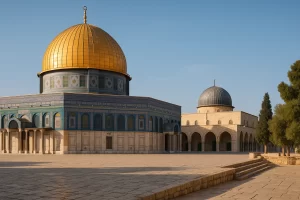In the heart of Jerusalem lies Al-Haram ash-Sharif, a sacred site that houses two of the most important Islamic structures: Masjid al-Aqsa and the Dome of the Rock. Though close in location, these sites have distinct roles in Islamic theology, history, and architecture. This blog explores their background, significance, and the questions people frequently ask about them.
What Is the Dome of the Rock and Why Is It Important?
The Dome of the Rock, built in 691 CE by Caliph Abd al-Malik, is a revered Islamic shrine—not a mosque—located in Jerusalem. It marks the location where Prophet Muhammad (PBUH) is believed to have ascended to heaven during the Isra and Miraj. This makes the site profoundly significant in Islamic belief.

Who Built the Dome of the Rock?
The Dome of the Rock was commissioned by Umayyad Caliph Abd al-Malik in 691 CE. It was one of the first grand architectural projects undertaken by a Muslim ruler, intended to emphasize the glory and permanence of Islam in Jerusalem.
Dome of the Rock Significance in Islam
- Site of Prophet Muhammad’s (PBUH) ascension to the heavens.
- Holds the Foundation Stone, revered across Islam, Judaism, and Christianity.
- A powerful symbol of Islamic presence in Jerusalem.
Why Is the Dome of the Rock Important to Christianity and Judaism?
- In Judaism, the Foundation Stone is believed to be the location of the Holy of Holies in the ancient Jewish Temples.
- Some Christians value the site due to its biblical and prophetic associations with Jerusalem and Solomon’s Temple.
Dome of the Rock Architecture: What Makes It Unique?
- Octagonal shape with a golden dome, restored during the Ottoman era.
- Features elaborate mosaics and Quranic inscriptions.
- Architectural masterpiece blending Byzantine and Islamic styles.
Is the Dome of the Rock a Mosque?
No. The Dome of the Rock is a shrine, not a mosque. Masjid al-Aqsa serves as the functioning mosque within the same compound.
When Was the Dome of the Rock Built?
It was completed in 691 CE, making it one of the oldest Islamic monuments still standing today.
Why Is the Dome of the Rock So Controversial?
- Located on a site claimed by Jews (Temple Mount) and Muslims (Al-Haram ash-Sharif).
- A flashpoint in Israeli-Palestinian tensions.
- Symbolizes deeper religious and political conflicts in the region.
What Is Hidden Under the Dome of the Rock?
Underneath lies the Foundation Stone, which has spiritual meaning in Islam, Judaism, and Christianity. Some believe it was the starting point of creation or the site where Abraham prepared to sacrifice his son.
Is the Dome of the Rock Made of Gold?
While the dome appears golden, it is covered with gold-plated aluminum, not solid gold.
Dome of the Rock Photos: A Visual Icon
The shrine is often featured in global media and travel photography, symbolizing Jerusalem and Islamic heritage. For anyone searching for images of Dome of the Rock or a picture of Dome of the Rock, this iconic golden dome stands as a symbol of Islamic Jerusalem and one of the most recognized structures in the world.
Is the Dome of the Rock in Israel or Palestine?
It is located in East Jerusalem, which is internationally recognized as occupied Palestinian territory, though claimed and controlled by Israel.
What Is Masjid al-Aqsa?
Masjid al-Aqsa is the third holiest site in Islam after Masjid al-Haram in Mecca and Masjid an-Nabawi in Medina. It is a mosque, distinct from the Dome of the Rock, and is located just meters away within the same complex.

Where Is Masjid al-Aqsa Located: Palestine or Israel?
Masjid al-Aqsa is located in East Jerusalem, within the Old City, an area recognized by the United Nations as part of Palestinian territory.
Al-Aqsa Mosque History
The Islamic history of Masjid al-Aqsa dates back to the earliest prophets. Scholars hold varied opinions:
- Hazrat Adam (AS): Some Islamic traditions claim he was the first to build it.
- Hazrat Ibrahim (AS) or Ismail (AS): Other sources suggest a later reconstruction by the prophets.
- Official Islamic history places significant renovations under Caliph Umar ibn al-Khattab and Abd al-Malik.
Who Built Masjid al-Aqsa First Time?
According to several Islamic narrations, Hazrat Adam (AS) laid the original foundation, making it possibly one of the oldest places of worship on Earth.
Al-Aqsa Mosque Significance
The importance of Masjid al-Aqsa in Islam cannot be overstated:
- Served as the first Qibla (direction of prayer) in Islam.
- Prophet Muhammad (PBUH) prayed here during the Isra, before ascending to the heavens from the Dome of the Rock.
- A symbol of unity among the Abrahamic faiths.
Why Is Masjid al-Aqsa Important to Israel?
Masjid al-Aqsa sits on a site also revered in Jewish tradition as the Temple Mount. Many Jews believe the First and Second Temples once stood on this location, hence its political and spiritual importance to both Muslims and Jews.
Why Is Al-Aqsa Mosque Important for Jews and Christians?
- For Jews, the Temple Mount is the holiest site, and they believe the Third Temple will one day be built there.
- Christians revere Jerusalem and its ancient holy sites, including Al-Aqsa, for their biblical history.
Why Is the Temple Mount Important to Islam?
The Temple Mount, known to Muslims as Al-Haram ash-Sharif, is home to both Masjid al-Aqsa and the Dome of the Rock. It is the site where the Isra and Miraj took place, making it a vital part of Islamic belief and history.
Dome of the Rock vs. Masjid al-Aqsa: Key Differences

Aspect |
Dome of the Rock |
Masjid al-Aqsa |
|---|---|---|
| Function | Shrine marking Prophet Muhammad’s ascension (Isra and Miraj) | Mosque used for daily prayers |
| Construction | Built in 691 CE by Caliph Abd al-Malik | Built by prophets; expanded by Islamic rulers |
| Architecture | Golden dome, octagonal base, mosaics | Silver dome, rectangular structure, prayer hall |
| Historical Role | Oldest Islamic monument | First Qibla in Islam |
| Location | East Jerusalem (Al-Haram ash-Sharif / Temple Mount) | Same compound, adjacent location |
Discover More Through the Muslim Directory App
Explore Islamic heritage, mosques, and holy sites with the Muslim Directory App. Whether you’re learning about the Isra and Miraj, planning a visit, or deepening your spiritual journey, our app connects you with:
- Nearby mosques and prayer spaces
- Accurate prayer times
- Over 400 verified Duas
- Qibla finder and Hijri calendar
Conclusion
Both the Dome of the Rock and Masjid al-Aqsa serve as enduring symbols of faith, resistance, and sacred history. One stands as a celestial portal in Islamic theology, the other as a historical and functional mosque revered by millions.
These structures are more than historical marvels—they are spiritual pillars in the hearts of Muslims worldwide. Understanding their architecture, origin, and religious roles helps foster deeper interfaith respect and appreciation.













